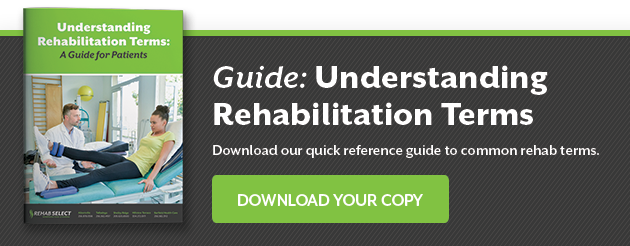
Today, over 1.8 million Americans are living with an amputation. Amputations may be medically necessary and, at times, even lifesaving, but they can also be deeply traumatic, both physically and emotionally. Amputation rehabilitation can help patients recover, increase their quality of life, and adjust to the new reality of life after the loss of a limb.
Reasons for Limb Amputations
The term amputation is used to describe the surgical removal of a limb or limbs. There are several reasons why an amputation may become the only course of treatment available.
Leg amputations are most commonly caused by peripheral arterial disease. Patients with this condition have very poor circulation, caused by narrow or damaged arteries. Without adequate blood circulation to a limb, the cells in that limb may become starved of oxygen. Over time, the affected tissue begins to die, which can result in potentially fatal infections.
Other causes of leg amputations include injury (such as motor vehicle accidents or severe burns), cancerous tumors in the bone or muscles, severe infections caused by diabetes, and frostbite. Arm amputations are less frequent. They are most commonly the result of an occupational injury, or, more rarely, made necessary to prevent the spread of cancer.
The Stages of Amputation Recovery
According to the online physical therapy journal Physiopedia, there are nine stages of recovery for amputees:
Stage 1: The process of amputation recovery begins before the surgery has even taken place. In this first stage, the medical team will begin by assessing the patient’s condition, discuss how much of the limb will be removed, and begin to educate the patient about the surgery and the expected outcomes.
Stage 2: During the amputation surgery, the doctor will remove all damaged tissue, and will aim to leave as much healthy tissue as possible. He or she will also smooth uneven areas of both and cut the muscles to enable the patient to use an artificial limb more easily.
Stage 3: Immediately after the surgery, the patient will be given pain relief and emotional support while the wound is treated and begins to heal.
Stages 4 – 6: During this phase, the medical team will focus on helping the patient regain both muscle strength and feelings of control over their body while preparing the amputated limb for the use of a prosthetic. The patient will then be fitted with an appropriate prosthetic and given training in how to use it.
Stage 7 – 8: During these two stages, the focus of treatment moves toward occupational therapy. The medical team will help the patient begin to integrate into the community and family, find emotional equilibrium, and engage in recreational activities. If necessary, the patient will also receive further training or job modifications to enable them to return to the workforce.
Stage 9: This is the maintenance phase, after the completion of the more intensive stages of amputation rehab. The patient will need ongoing medical assessments and support in the long-term use of a prosthetic and may well also require emotional support to continue to adjust to their new reality.
What is Amputation Rehab?
Amputation rehabilitation is a form of rehabilitative therapy aimed at helping patients recover from amputations, both physically and emotionally. Amputation rehab is a type of orthopedic rehab treatment specifically designed for patients who have lost a limb or limbs. The loss of a limb is a permanent disability, and it can have a major impact on a patient’s mobility, independence, and self-image. Amputation rehab usually begins immediately after surgery (Stage 3) and continues over the long term.
According to Stanford Health Care, an amputation rehab program will usually include:
- Orthopedic physical therapy to help build muscle strength and mobility;
- Occupational therapy, to help increase the patient’s independence;
- Specialized wound care to help the stump heal more quickly;
- Emotional support, such as counseling or psychotherapy;
- Pain management;
- Training in the use of prosthetics and other assistive devices;
- Vocational counseling and job modification;
- Patient and family education, to help ease the patient’s return to daily life.
What Are the Benefits of Amputation Rehab?
As with all forms of orthopedic rehabilitation, the main goal of amputation rehab is to help the patient achieve the highest possible quality of life, despite their disability. There are numerous other benefits for amputation patients, including:
1. Less pain
Patients recovering from amputations can experience high levels of pain. One of the main objectives of an amputation rehab program will be to help manage pain more effectively, both by the effective use of medications and by increasing the strength of supporting muscles to reduce the pressure on the stump.
2. Reduced risk of depression
As many as 30% of amputees suffer from post-operative depression. Rehabilitation can help. Patients will receive extensive training on how to manage their new physical reality, as well as emotional support and counseling to help deal with issues like post-traumatic stress disorder, body image, phantom limb pain, and grief.
3. Education on using artificial limbs
Getting used to a prosthetic can be a major challenge for many people. The rehab team can help patients understand how to manage with prosthetics and other assistive devices and avoid injuries from incorrect use.
4. Increased strength and mobility
Orthopedic physical therapy is designed to help patients gain progressive muscle strength, tone, and flexibility over time, making it easier for patients to return to their daily lives.
5. Greater independence
It can be hard for patients to care for themselves immediately after amputation. However, during amputation rehab, the patient will learn how to manage day-to-day activities by themselves. With ongoing patient education and training, they’ll gain increased confidence as their understanding of their condition grows. The rehab team can also help to identify modifications to the home or workplace that can make it easier for the patient to manage on their own.
Amputations can be physically and emotionally traumatic, but specialized amputation rehab at an orthopedic rehab facility can help. If you’d like to learn more about the amputation rehabilitation services available at Rehab Select’s facilities, please visit our website or click here to contact us.





